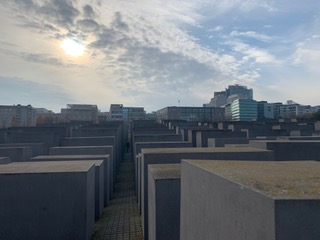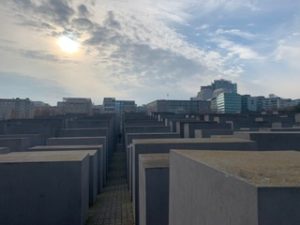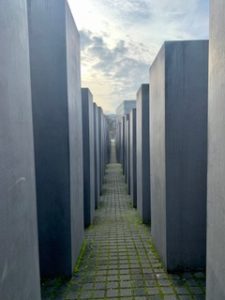Public Memory and Remembrance in Berlin
By Ella Farrell
With over fifty memorials and monuments, the city of Berlin is no stranger to remembrance. Two memorials in particular, the Monument to the Murdered Jews of Europe and the Places of Remembrance, stand out from our visit to the city. Both are integrated into the urban fabric of the city, yet the ways in which the memorials shape the public’s understanding of the tragedy that they represent are very distinct.
The Monument to the Murdered Jews of Europe is located in the center of Berlin, only blocks away from the Brandenburg Gate and the Reichstag Building. At first glance, the monument seems to consist of simple stone blocks that are sequentially larger, starting from where the visitor stands at the sidewalk. It can be difficult to locate information about the monument and what it represents, as the only informative plaques are located on the ground and not in the visitor’s line of sight. As you enter the monument, you realize the ground is not level, but rather curving under your feet. The sense of being enveloped by these great concrete blocks is overwhelming and you are suddenly aware of your solitude when you realize that you can no longer see any other visitors at the monument. This piece is left up to interpretation by each visitor, which can lead to both positive and negative interactions with the monument.
Some of the positive interactions with the Monument to the Murdered Jews of Europe contribute to a deeper understanding of the loss of the Holocaust. Because the monument is located in the heart of the city, thousands of people visit or pass by the space daily. It is an ever-present reminder that the families of those who perished should be living alongside the families of those who didn’t. By having a defined place in the city, the monument gives people a space to grieve and to pay their respects. Most visitors come with a defined purpose to see the monument and to reflect on the horror that led to the creation of this piece. These types of interactions that lead to a deeper understanding of the memory of the Holocaust are what was intended by placing the monument in this space in Berlin.
Even with all the positive interactions at the monument, there are unfortunately plenty of inappropriate and negative experiences that can be seen in this space as well. Because the monument is meant to be interpreted by the individual, the anonymity can be frustrating. The space can also be stumbled upon by visitors because it is in the middle of the city and doesn’t have clear identification. This leads to the space being used as a playground for children or as a backdrop for influencers who need new Instagram photos. Those who do not come to this monument with the intention of honoring the victims often do not understand the significance, and therefore disrespect the space and the lives of those who the space represents, even if it is unintentional.
Another unique memorial in Berlin is the Places of Remembrance, which is a rather atypical method of commemoration. This memorial consists of a series of signs placed in the Bavarian Quarter, a formerly Jewish neighborhood, in the city of Berlin. Each sign has a different illustration, accompanied by a new, discriminatory regulation that the Jewish residents of the neighborhood had to follow starting in 1933. For example, an image of a plug displays the rule that all Jews must turn in any electrical devices, including anything from hair dryers to radio sets. These signs are placed throughout the neighborhood, which forces those who reside in the area or frequently visit to live with the history. The daily confrontation of these signs reminds us how easily the rights of citizens can be taken away and what it might lead to.
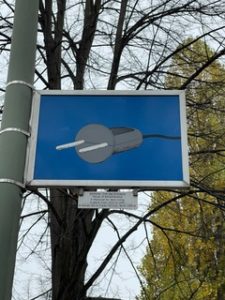
Places of Remembrance sign demonstrating the law, “Jews must hand over all electrical and optical appliances, bicycles, typewriters, and records.” Photo credits: Capriana Cormier
The Places of Remembrance, while different from the typical vision of a memorial, is a unique way to confront the history and memory of the area as you move through the space. Because the memorial is so integrated within the neighborhood, it forces the visitor to understand how prevalent these exclusionary laws were in the lives of Jewish residents, almost as if there were new regulations around every corner. The project also takes up less space than other monuments because it is spread out over multiple streets. These signs allow anyone, even a leisurely stroller or a recreational biker, to understand the purpose and significance of the memorial. The phrases describing the prejudiced restrictions are short and easy to comprehend, which allows for the memory of these horrific laws and their consequences to remain in public memory in the present.
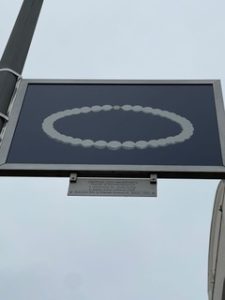
Places of Remembrance sign demonstrating the law, “Jewelry, items made of gold, silver, or platinum, and pearls belonging to Jews are to be turned to the State.” Photo credits: Capriana Cormier
Although the decentralized memorial has many great qualities, there are also many drawbacks to this type of project. Without a central monument, there is no place for visitors to pay their respects to those who were victimized by the racist laws implemented between 1933 to 1945 that the signs represent. Another topic of controversy in regard to the Places of Remembrance is the reaction from the local community that lives in the neighborhood where the signs are placed. Using Nazi language and rhetoric in the present is uncomfortable for many of the residents, as they do not want to be associated with the history of the Third Reich. Additionally, visitors don’t typically come to the area with the purpose of visiting this memorial. The Bavarian Quarter is a beautiful, upscale neighborhood and most tourists do not know about the Places of Remembrance that is located in this space. The project can also easily be ignored by visitors because it is above eye level and doesn’t catch one’s attention as easily as a monument of huge concrete blocks might.
Both the Monument to the Murdered Jews of Europe and Places of Remembrance honor victims of the Holocaust in different ways. Involving these memorials in the center of city spaces greatly contributes to the public memory and recognition of this tragedy. Although there are shortcomings as in any monument, these two examples offer spaces to remember and reconcile with the past in unique ways.

